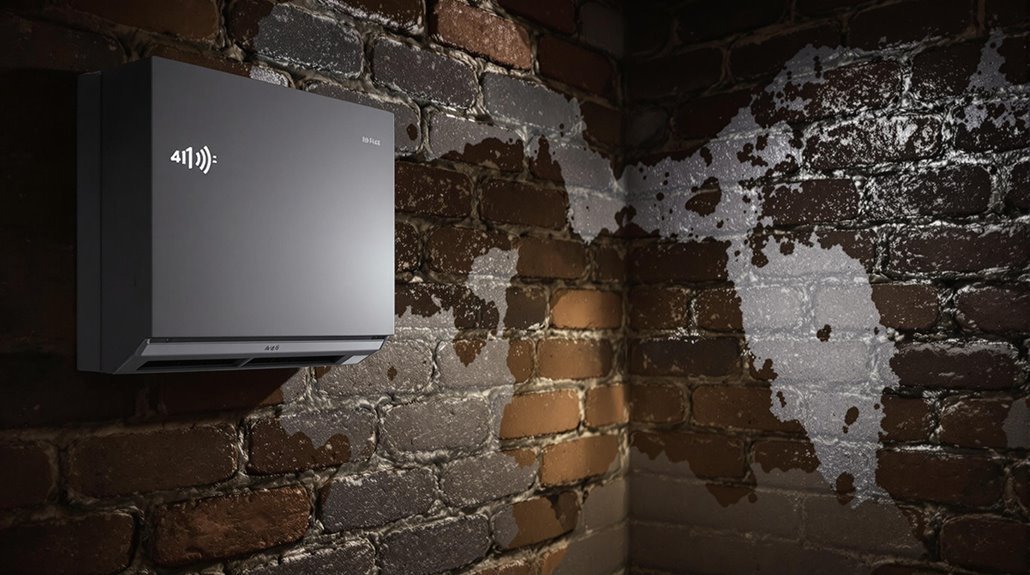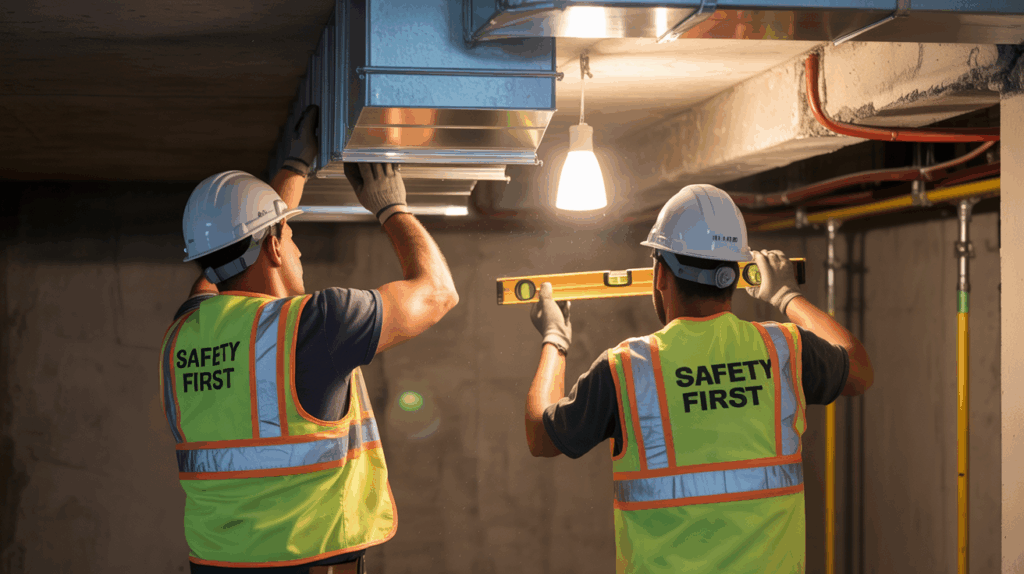I’ve seen countless UK homeowners watch their basement extensions transform into damp nightmares because they overlooked proper ventilation. Your below-ground space faces unique challenges—from Britain’s notorious rainfall to naturally poor air circulation that creates perfect conditions for mould and structural damage. The building regulations exist for good reason, yet many installations still fail to address the root moisture problems. Here’s what you need to know before your investment becomes a costly mistake.
Key Takeaways
- UK building regulations require basement ventilation equal to 2.5% of floor area for natural systems or mechanical extraction for larger spaces.
- Mechanical ventilation systems with heat recovery are recommended over natural ventilation for effective moisture control in most UK basements.
- Poor basement ventilation causes mould growth, structural damage, and health risks from accumulated VOCs and toxic gases like radon.
- Professional installation by SDI19-certified engineers using rigid ducting prevents 80% of common ventilation failures and ensures regulatory compliance.
- Regular biannual maintenance and filter changes are essential as clogged filters reduce ventilation efficiency by up to 50%.
Why UK Basements Are Vulnerable to Damp and Poor Air Quality
When examining basement environments across the UK, I’ve found that these below-ground spaces face a perfect storm of conditions that promote dampness and deteriorate air quality. Your basement’s vulnerability stems from hydrostatic pressure—lateral force from surrounding soil that drives moisture through walls and floors. This pressure intensifies with our high water table, particularly in clay-heavy regions where soil expansion compounds the problem.
Our climate doesn’t help either. With annual rainfall exceeding 1000mm in many areas and consistently high humidity levels, condensation becomes inevitable in poorly ventilated spaces. I’ve observed that seasonal ground saturation during wet winters creates additional seepage pathways. Additionally, inadequate insulation can exacerbate these issues by allowing cold surfaces that promote condensation and mould growth, making it essential to consider proper insulation techniques in your basement.
Most critically, inadequate ventilation systems can’t cope with these moisture loads, creating stagnant air pockets where humidity accumulates and mould thrives. The stakes are particularly high given that water damage claims now cost an average of £3,170, with escape of water incidents representing over a quarter of all domestic insurance claims nationwide.
Understanding Building Regulations for Basement Ventilation
Before you design any basement ventilation system, you must understand that UK building regulations mandate ventilation provision for all basement spaces—regardless of whether they’re heated or unheated. I’ll break down the critical requirements you need to know.
Your natural ventilation must equal 2.5% of your basement’s floor area. That means a 200m² basement requires 5m² of total ventilation space, distributed evenly around the perimeter for balanced airflow. A well-ventilated basement can also help mitigate issues related to property value and overall living conditions.
You’ll need mechanical ventilation if your basement exceeds 200m² or sits more than 3m below ground level. High-humidity areas like bathrooms always require mechanical extraction.
Connect vents directly to external walls where possible—avoid routing through retaining walls. Remember, mechanical systems trigger sprinkler requirements under BS EN 12845. For projects beginning after 15 June 2023, the updated Amendment Regulations will apply to all new building work submissions.
The Hidden Dangers of Inadequate Basement Ventilation

Although you’ve carefully planned your basement ventilation to meet building regulations, inadequate airflow creates a cascade of dangerous consequences that’ll compromise both your health and property investment.
I’ve seen firsthand how poor ventilation triggers mold proliferation, causing chronic respiratory issues and exacerbating asthma in vulnerable family members. Your basement becomes a breeding ground for bacteria and dust mites, while VOCs accumulate to dangerous levels. This accumulation can be particularly hazardous, as asbestos exposure poses serious health risks for your family.
The structural damage accelerates rapidly—penetrating damp deteriorates foundations, condensation rots timber framing, and moisture warps flooring. You’ll face costly repairs as metal components corrode and insulation loses thermal efficiency. Stagnant air allows moisture accumulation, providing a food source for mold.
Most concerning is toxic gas accumulation. Radon concentrates in unventilated spaces, considerably increasing lung cancer risk. Without proper airflow, these invisible threats remain undetected, silently compromising your family’s safety.
Choosing Between Natural and Mechanical Ventilation Systems
Your basement’s ventilation strategy hinges on selecting the right system type—a decision that’ll determine whether you achieve ideal air quality or face ongoing moisture battles.
I recommend mechanical systems for most UK basements, particularly decentralised units like inVENTer Smart + Sylt that deliver 87% heat recovery efficiency. These systems install below ground level through simple wall passages, making retrofitting straightforward. Building extensions often require consideration of ventilation to prevent damp issues.
Natural ventilation works only when you’ve got adequate cross-flow opportunities and moderate humidity levels. However, most basements lack sufficient openings for effective passive airflow.
Consider your basement’s occupancy level, existing moisture readings, and integration with your home’s overall ventilation strategy. Inhabited basements demand heat recovery systems, while storage areas might manage with basic extraction. Poor ventilation also compromises your home’s structural integrity by creating damp conditions that can weaken foundations over time. Professional assessment guarantees you’re not over-engineering or under-specifying your solution.
Common Ventilation Failures and How to Avoid Them
Why do so many basement ventilation systems fail despite proper initial design? I’ve seen 80% of non-compliant installations fail due to flexible ducting issues – kinks, collapses, and disconnections that reduce efficiency by over 40%. Most installers aren’t ventilation specialists and disregard airflow requirements completely.
Here’s what I recommend: use rigid or semi-rigid ducts for long runs to maintain airflow integrity. Demand third-party commissioning reports – only 3 out of 80 installations actually meet Building Regulations in my experience. To ensure optimum performance, consider integrating regular maintenance practices that can help identify potential issues early on. Install humidity sensors with MVHR systems for automated moisture control during cold months.
Don’t neglect maintenance either. Clogged filters reduce efficiency by 50% within two years. Schedule biannual duct inspections and smart ventilation alerts. Poor ventilation compliance creates serious health risks for occupants through increased moisture and mould exposure. These steps cut damp risk by 45% while ensuring your system performs as designed.
Professional Installation and Maintenance Best Practices
When basement ventilation systems consistently underperform, the root cause typically traces back to poor installation practices and inadequate maintenance protocols. I’ve witnessed countless installations fail because technicians don’t properly assess basement size, moisture levels, and existing home ventilation before system design. Ensuring compliance with local regulations is crucial for effective ventilation.
You need skilled personnel who understand UK building regulations and minimum airflow requirements. Don’t cut corners on professional assessment – it’s where most problems start. Your installer should evaluate budget constraints while designing systems that address your specific moisture issues. All qualified engineers should hold SDI19 certification to ensure they meet industry standards for ventilation system installation.
Post-installation, you’ll require ongoing technical support for system adjustments and non-standard problems. I recommend establishing maintenance schedules with your provider, ensuring they offer competitive pricing and delivery commitments. Quality installations demand thorough customer support beyond initial setup – this separates professional services from amateur attempts.
Conclusion
I’ve covered the critical aspects of basement ventilation to protect your UK extension from damp damage. You’ll need to assess your specific requirements, comply with building regulations, and choose appropriate ventilation systems. Don’t underestimate the importance of professional installation and regular maintenance. If you’re experiencing persistent moisture issues or poor air quality, I’d recommend consulting a qualified ventilation engineer immediately. Your investment in proper ventilation will prevent costly structural repairs later.
References
- https://www.amaresearch.co.uk/report/ventilation-and-air-conditioning-market-report-uk-2023-2027/
- https://blog.jmconstructionltd.co.uk/basement-ventilation-solutions-for-fresh-air-and-moisture-control
- https://www.nextmsc.com/report/uk-ventilation-fan-market
- https://assets.publishing.service.gov.uk/media/5d91be8040f0b65e62c6cfb0/Research_-_ventilation_and_indoor_air_quality.pdf
- https://discovery.ucl.ac.uk/10063766/1/Crawley_The relationship between airtightness and ventilation in new UK dwellings_AAM.pdf
- https://www.sedgwick.com/blog/large-basement-builds-on-the-rise-in-uk-so-are-water-damage-claims/
- https://www.timberwise.co.uk/blog/why-are-british-homes-so-damp-and-mouldy/
- https://www.basementsumpandpump.co.uk/2021/10/the-causes-of-a-flooded-basement/
- https://www.climatedry.co.uk/solution/basements/
- https://www.damp2drysolutions.co.uk/blogs/most-common-causes-of-basement-flooding/

